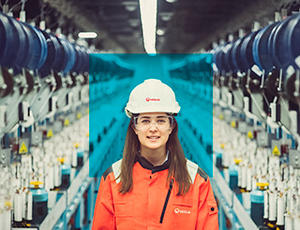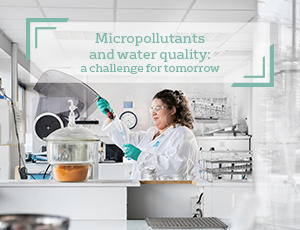We provide innovative solutions to effectively treat micropollutants in water, residue that is invisible to the naked eye and can interfere with biological systems. Various undesirable compounds may be present in water, including micropollutants.
What are micropollutants?
Micropollutants can include residue from detergent, pesticide metabolites, medicines, cosmetics, hydrocarbons, etc. Invisible to the naked eye, they are present in water at very low concentrations, in the order of micrograms or even nanograms per liter. Some of these micropollutants are endocrine disruptors, i.e., they can disrupt the biological functions of living things.
We are addressing this problem with very concrete solutions to remove these micropollutants from water. We support cities, industries and the tertiary sector in removing micropollutants in wastewater, in order to protect human health and biodiversity.
Endocrine disruptors, definition:
According to the WHO, an endocrine disruptor is a chemical substance of natural or synthetic origin, foreign to an organism and likely to interfere with the functioning of the endocrine system. Endocrine disruptors disrupt the hormonal functioning of living organisms and have harmful effects on the environment and human health.
Where do micropollutants in water come from?
Residue from various human activities is collected in wastewater. It comes from domestic uses (household products, molecules resulting from the use of plastic, solvents, medicines, etc.), agriculture, transportation, industry and professional trades.
During treatment in wastewater plants, some micropollutants end up in aquatic environments because they haven’t been removed. Treating micropollutants is highly complex and conventional technologies cannot completely remove them. In Europe, there are no regulations regarding the standards and reference values that should be respected concerning the presence of these residues in water. This is partly explained by the lack of knowledge about the health and environmental impact of these molecules and the cocktail effect that some may have when combined. However, there is growing awareness and science is making headway. Veolia expects regulations to become stricter. With its subsidiary Veolia Water Technologies, the Group already provides innovative solutions that efficiently treat these micropollutants in water.
Browse our solutions for treating industrial wastewater >
How do we eliminate micropollutants in water?
Thanks to our expertise in water management, we design and deploy innovative technologies to remove micropollutants.
- ACTIFLO® Carb : Equipped with a pre-contact tank with powdered activated carbon for adsorption and combined with the oxidizing action of ozone, this process eliminates 95% of endocrine disruptors. Find out more.
- Opacarb® FL : An up-flow stream reactor consisting of a micro-granular activated carbon bed which adsorbs organic materials and micropollutants including pesticides, endocrine disruptors, and pharmaceutical residue.
- Filtraflo® Carb : Designed for lower flow rates than the Opacarb® FL, this process eliminates micropollutants in water by adsorption, but also filters them simultaneously through a reactor with micronized powdered activated carbon operating in a counter-current. Find out more.
- Opaline™C : This process, which can be used with the oxidizing action of ozone, combines membrane technology and adsorption using activated carbon for improved removal of pesticides, endocrine disruptors, etc. Find out more.
- MBBR (Moving Bed Biofilm Reactor) technology: A moving bed biofilm reactor process to biologically treat micropollutants, including medicine, personal hygiene products, and industrial chemical compounds in wastewater
It is with these types of technologies that we are contributing to the removal of micropollutants in wastewater in order to improve human health and reduce the impact of wastewater on biodiversity.
Browse our advanced solutions for wastewater network management >

Fight against micropollutants in water
What are the benefits for you as an industrial concern, community or in the tertiary sector?
- You help improve water quality
- You reduce health risks from water consumption
- You help maintain biodiversity
- You benefit from the 170 years of expertise of the world leader in water and sanitation services
We did it!

Denmark
In Aarhus, we treat micropollutants in the city's wastewater. With our MBBR (Moving Bed Biofilm Reactor) solution, 90% of medication residue is removed.

France
At the Amphitria wastewater treatment plant in Cap Sicié, we are conducting tests to identify the presence of micropollutants, implement appropriate solutions and support the University of Toulon in its fight against emerging pollutants in the Mediterranean.

Switzerland
In 2019, the ARA Altenrhein (Switzerland) wastewater treatment plant became the first such plant in the world to use an innovative system combining Veolia’s Ozonia technology and activated carbon filtration to treat micropollutants targeted by Swiss regulations.

Switzerland
In Lucerne, as part of the protection of Lake Lucerne, we developed a pilot project to trap molecules in wastewater by adding activated carbon filtration steps to our Actiflo® technology.




